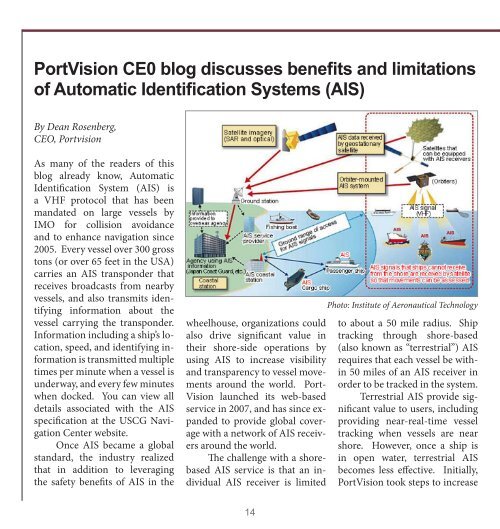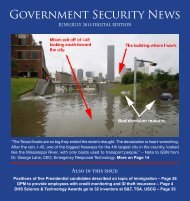Government Security News
You also want an ePaper? Increase the reach of your titles
YUMPU automatically turns print PDFs into web optimized ePapers that Google loves.
PortVision CE0 blog discusses benefits and limitations<br />
of Automatic Identification Systems (AIS)<br />
By Dean Rosenberg,<br />
CEO, Portvision<br />
As many of the readers of this<br />
blog already know, Automatic<br />
Identification System (AIS) is<br />
a VHF protocol that has been<br />
mandated on large vessels by<br />
IMO for collision avoidance<br />
and to enhance navigation since<br />
2005. Every vessel over 300 gross<br />
tons (or over 65 feet in the USA)<br />
carries an AIS transponder that<br />
receives broadcasts from nearby<br />
vessels, and also transmits identifying<br />
information about the<br />
vessel carrying the transponder.<br />
Information including a ship’s location,<br />
speed, and identifying information<br />
is transmitted multiple<br />
times per minute when a vessel is<br />
underway, and every few minutes<br />
when docked. You can view all<br />
details associated with the AIS<br />
specification at the USCG Navigation<br />
Center website.<br />
Once AIS became a global<br />
standard, the industry realized<br />
that in addition to leveraging<br />
the safety benefits of AIS in the<br />
wheelhouse, organizations could<br />
also drive significant value in<br />
their shore-side operations by<br />
using AIS to increase visibility<br />
and transparency to vessel movements<br />
around the world. Port-<br />
Vision launched its web-based<br />
service in 2007, and has since expanded<br />
to provide global coverage<br />
with a network of AIS receivers<br />
around the world.<br />
The challenge with a shorebased<br />
AIS service is that an individual<br />
AIS receiver is limited<br />
Photo: Institute of Aeronautical Technology<br />
to about a 50 mile radius. Ship<br />
tracking through shore-based<br />
(also known as “terrestrial”) AIS<br />
requires that each vessel be within<br />
50 miles of an AIS receiver in<br />
order to be tracked in the system.<br />
Terrestrial AIS provide significant<br />
value to users, including<br />
providing near-real-time vessel<br />
tracking when vessels are near<br />
shore. However, once a ship is<br />
in open water, terrestrial AIS<br />
becomes less effective. Initially,<br />
PortVision took steps to increase<br />
14







